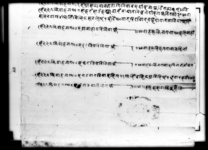A record of tax paid by Lhasa merchants in Sankhu Custom Office (NS 995)
ID: E_1448_0045
Edited and
translated by Bal Gopal Shrestha
in collaboration with
Pabitra Bajracharya
Created: 2016-12-07;
Last modified: 2018-04-12
For the metadata of the document, click here
The accompanying edition, translation/synopsis and/or commentary are available under the terms of the Creative Commons Attribution-ShareAlike 4.0 International License
Abstract
This documents records the duties paid at the customs office at Shakhu Vajrayoginī in year 1885 AD. It provides a list of people who were obliged to pay the duties, and the kind of payments they made in cash.Diplomatic edition
[1r-part1]
1\सं९९५म्तिपोहेराथ्व२सथ्यंकओपिं2विरधुमुनिरच्छिंनरसिंसितिधंजि
3तमासिंहर्खविरसिंम्हं५स्यागुमू
4दांपुरायारजुरशुभं1\सं९९५म्तिपोहेरागा५सग्वभाजु
2यातनिचोनेतवियाधुंकायाविया
3मुसिग्व८खोसिंसिव़सिकशुथू१धुं
4पा१सरतका।।पूउदांरति१५वोकि
5अद्यारुथुरिविया1\सं९९५म्तिपोहेराथ्व२सश्रीसकोयावज्रजोगिनियातमुदांपुराम्हतिंतका२भुधरि
2\सं९९५म्तिपोहेराथ्व७सकुभंसारंकुच्छ्याकाभंसायातनिच्वनेदांपुराम्हतिंतका३०ध्यवा
3मुसितयाग्व४खोसिंमिसिकसुवसिथु१धुंदिथायातखर्दायातवहिदायातयावियाम्हतिं
4\सं९९५म्तिपोहेरागा६सत्वामाहापतिविया म्हं¯¯¯¯¯¯¯¯¯¯¯ ।।ध्यवाहस्तेकिरागयाथकुसिमाहां
5\सं९९५म्तिपोहेरागा६सवुभरिपतिवियाम्हं¯¯¯¯¯¯¯¯¯¯¯ ३//ध्यवाहस्तेसिन्हग्वदायारच्छिनां
6\सं९९५म्तिपोहेरागा६सछेभरिपतिवियाम्हं¯¯¯¯¯¯¯¯¯¯¯ ३//ध्यवाहस्तेकिरागयाधुनिराजबांम्हन
7\सं९९५म्तिपोहेरागा६सनउयातमुसिग्व१२खोसिंवसिक शु मिसिथु१धुंपा१सरंतयाविया
[1r-part2]
8\सं९९५म्तिपोहेरागा८ [स]चारकाजिवियाम्हं१।।।ध्यवाहस्तेन्हुसायाकिष्न्हुसामि
Translation
[1r-part1]
The five persons—Birdhu Muni, Racchiṃ Narasiṃ, Sitidhaṃ, Jitamā Siṃ, and Harkhabir Siṃ—-who arrived on the 2nd day of the bright half of the month of Pohelā in [NS] 995 (1885 CE) have completed the main [tax] payment. Auspiciousness.
On the 5th day of the dark half of the month of Pohelā in 995 [NS] the Buddhist priest was given these things: 8 logs of wood, a bunch of straw, 1 plate (pā) of incense, one hundred rupees and 2 ānās, and pū dāṃ rati 15 voki1 .
On the 2nd day of the bright half of the month of Pohelā in 995 [NS] at Sako Vajrayogini the main payment was made, [at the rate of] 2 rupees each.
On the 7th day of the bright half of the month of Pohelā in 995 [NS], the Ku customs office made a payment 30 rupees each to the Kucchyā customs for the purification ritual (ni cone). Each one gave wood, a bunch of straw, 4 walnuts 1 incense to the ḍiṭṭhā, kharadāra and bahidāra.
On the 6th day of the dark half of the month of Pohelā in 995 [NS], money amounting to 2 sukās each was paid to the soldier of the quarter through Thakusi Māhāṃ of Kirāga2 .
On the 6th day of the dark half of the month of Pohelā in 995 [NS], money amounting to 3 rupees and 2 ānās each was paid to the land management officer (bu bhari) through Racchināṃ of Sinhangvadā.
On the 6th day of the dark half of the month of Pohelā in 995 [NS], money amounting to 3 rupees and 2 ānās each was paid to the house management officer (che bhari) through Dhunirāja Bāṃhmana of Kirāga.
On the 6th day of the dark half of the month of Pohelā in 995 [NS], [following] was given to the barber (nau): a wood log, 12 walnuts, 1 sack of straw, 1 plate of incense.
[1r-part2]
On the 8th day of the dark half of the month of Pohelā in 995 [NS], money amounting to 1 rupee and 3 sukās each were paid to the four kājīs through Kiṣnhu Sāmi of Nhusā.
Commentary
This text provides a description of the revenues paid by various people at the Sankhu Vajrayoginī revenue office in year 1885 AD, however, from the document it is not clear why the revenues were charged. Since Sankhu was on the trade route from Kathmandu to Tibet, it is likely that taxes were charged for the goods merchants carried either from Tibet or to Tibet. It does not however provide any list of goods on which the duties were applied.


